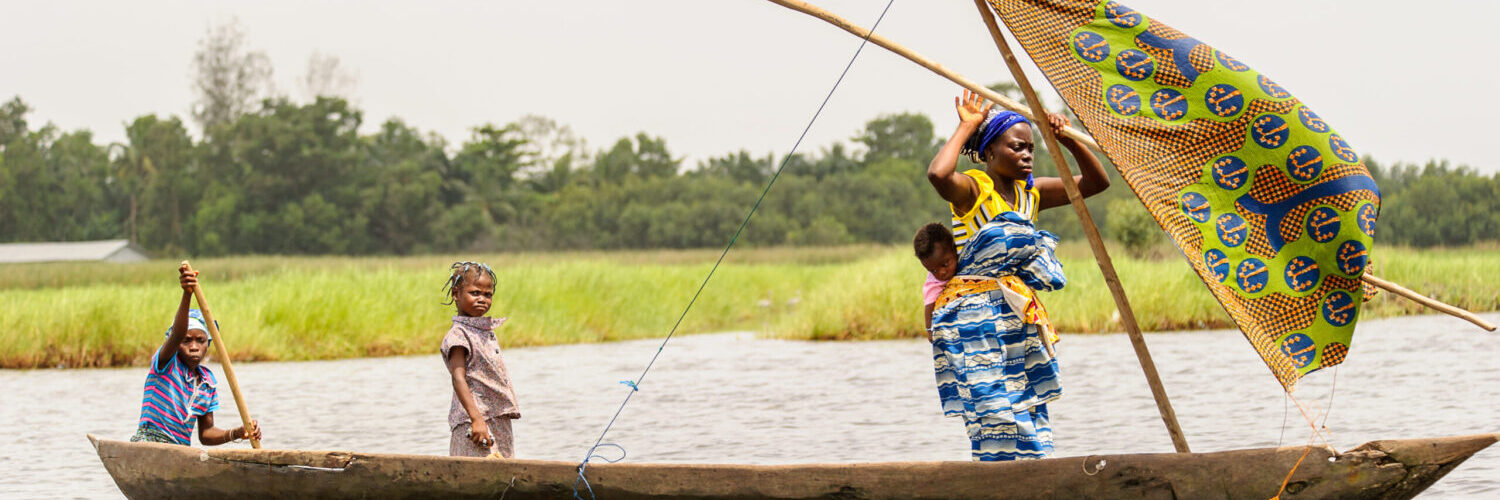Kalkidan Yibeltal
BBC News, Addis Ababa
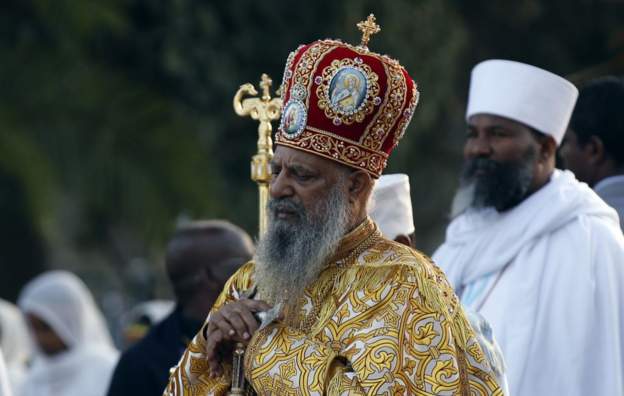
The top leadership, or synod, of Ethiopia’s Orthodox church, the largest religious denomination in the country, has threatened to call nationwide rallies to be led by its patriarch, Abuna Mathias.
The church has criticised Prime Minister Abiy Ahmed’s recent statements regarding rogue clergy involved in the appointment of bishops without its knowledge.
Mr Abiy’s lengthy remarks, broadcast on national television on Tuesday, came after the church’s synod excommunicated the breakaway clergy, who are from the country’s Oromia region.
He warned his cabinet members against getting involved in the church’s affairs. However, he said both sides “have truths.”
The synod said the PM’s remarks disregarded its decisions, challenged its authority and gave recognition to an “illegitimate power-hungry” group.
Some of Mr Abiy’s statements were “misleading”, it added.
The breakaway clergy accuse the church of maintaining a system of linguistic and cultural hegemony in which congregations in Oromia are not served in their native languages. The church denies the accusation.
The breakaway clergy said they had “overwhelming” public support after touring some areas in the conflict-prone western Oromia.
The synod’s statement comes amid accusations among the faithful that authorities are supporting the breakaway clergy.
It accuses the government of harassing and detaining its senior figures. It vows to continue to speak out even if they [senior religious leaders] have to “sacrifice their lives.”
Relationships between Mr Abiy’s administration and the church – which boasts nearly half of Ethiopia’s 110 million population as its adherents – were positive in the early days of his tenure.
However, in recent years members of the faith group have reported being targeted.
Relations became particularly strained during the heights of the Tigray war after Abuna Mathias spoke against what he called genocide in the region.
Errors found in Mozambique textbooks despite assurance
Jose Tembe
BBC News, Maputo

Errors have been detected in Mozambique textbooks for the second year despite recent assurances by the education ministry that it would not happen again.
Some errors were reported in Grade Six books last year – and this year the irregularities have surfaced in textbooks for the fifth and eighth grades.
A book published by Plura Editora for the Portuguese subject for Grade Eight starts on page 16, with the preceding pages misplaced elsewhere in the book.
On the first page, the book is printed upside down and a student would have to turn it over to read after opening the cover. Some other pages are also upside down.
In addition, photos of two same Portuguese subject textbooks for fifth grade with completely different covers have been shared on social media.
The first has a cover photograph of a girl smiling and dressed in a brown and white pullover, while the second shows a girl in a blue blouse and holding a pencil.
The errors were noted as schools throughout the country re-opened this Wednesday, with pictures of the errors being shared on social media.
A spokesman for the education ministry, Feliciano Mahalambe, recently gave assurances that the books that were due for distribution this year had been prepared and reviewed by a fully qualified team to avoid past mistakes.
A Grade Six book was withdrawn from schools last year after the discovery of errors including the erroneously listing of Mozambique as being in the East African region rather than a country in the Southern African region and showed landlocked Zimbabwe as bordering the Red Sea.
1 million flock to pope’s Congo Mass on day of forgiveness
AFP , AP , Wednesday 1 Feb 2023
An estimated 1 million joyous Congolese poured into the capital’s main airport Wednesday for Pope Francis’ first big Mass in Africa, on a day dedicated to his call for peace and forgiveness in a country wracked by decades of violence.

Many of the Congolese faithful spent the night on the vast airfields of Kinshasa’s Ndolo airport and passed the hours before Francis’ arrival singing, dancing and getting jazzed up for the first papal visit to the overwhelmingly Christian country since St. John Paul II’s last trip in 1985.
They cheered wildly when Francis began a languid loop around the airfields in his open-sided popemobile, some of them running alongside or waving flags. Many of the women wore dresses and skirts made of pagne, a wax print fabric featuring images of Francis or other religious symbols.
“Today I understand the enthusiasm of my grandmother when Pope John Paul II came,” said Julie Mbuyi, a 45-year-old mother of two who was wearing a Francis-themed outfit. “She was so excited to see him and the night before she couldn’t close her eyes!”
The morning Mass was Francis’ first big event in Congo after he arrived on Tuesday and, in his opening speech to government authorities, condemned the centuries-long plundering of Africa’s mineral and natural wealth by foreign powers.
Later Tuesday, Francis was to meet with victims of the fighting in Congo’s east, where rebel groups have intensified attacks over the past year as they seek to expand their territory.
Francis had originally planned to visit the North Kivu provincial capital, Goma, but had to cancel the stop due to the fighting that has forced some 5.7 million people to flee their homes, exacerbating a humanitarian crisis in Congo where already some 26.4 million people were facing hunger, according to the World Food Program.
“When we heard that Pope Francis was no longer coming to our province of North Kivu, my husband and I decided to come all the way to Kinshasa to see and hear him,” said Jeanne Kahota as she waited for Francis’ Mass to begin. She said she was old enough to remember John Paul’s visit, but wasn’t able to follow it closely.
“That’s why we said to ourselves that this kind of appointment doesn’t happen every day, it’s exceptional and we didn’t want to miss it again.”
Fighting in eastern Congo, which has more than 120 armed groups, has simmered for years but spiked in late 2021 with the resurgence of the M23 group, which had been largely dormant for nearly a decade. The rebels have captured swaths of land and are accused by the United Nations and rights groups of committing atrocities against civilians.
Francis on Tuesday condemned the fighting and was to repeat his call for peace during his meeting with victims of the conflict. The appointment was to include a joint call for the victims to pardon their assailants, according to Vatican organizers.
The Vatican estimated that 1 million people were on hand for Francis’ Mass, citing local organizers. The airport fields had a capacity of 1.5 million people and were not full by the time Francis’ Mass began.
Among the faithful was Clement L’onde, who travelled from Kisantu, a town in the province of Central Kongo, more than 150 kilometers from Kinshasa. He planned to participate in all of Francis’ events.
“To my children and to the children who stayed in my city, I will bring them the message of the Holy Father, the message of peace and reconciliation,“ he said.
Morocco’s National Finery Museum reopens after massive refurbish
AP Photo
The Bizmoun necklace is the oldest piece of jewellery in the world.
It’s on display at the National Finery Museum in Rabat, Morocco, a building which has reopened its doors after years of renovations.
The necklace, made of 32 perforated shells, was found in 2019 in the Bizmoun cave near Essaouira.
“The oldest piece displayed here is the Bizmoun necklace, which is the oldest jewellery in the world, not only in Morocco, and it dates back 150,000 years. It was discovered in recent excavations in the Bizmoun cave near Essaouira. Thanks to it, we can start the investigative path and learn about the development of historical jewellery,” says Fatima Zahra Khlifi, curator, National Finery Museum.
The museum has artistic, cultural, and also historical value.
Before hosting exhibitions, it was a princely residence in the 17th century.
The building has been a museum since 1915, and it was called Oudaya museum until 2006.
The renovation works started in early 2020 and ended in late 2022.
Now called National Finery Museum, the building was inaugurated in early January.
After it opened, Morocco’s King Mohammed VI gifted 350 items from his collection to the museum.
“The goal of the restoration and rehabilitation of the building was to meet all the appropriate standards for the approval of the museum displays and receive offers, both at the national and international levels, while respecting the characteristics of the building. Then, there were workshops through which the selection, inventory and maintenance of the contents took place in order to enrich these exhibitions, without forgetting King Mohamed VI’s gift that he made available to us,” says Zahra Khlifi.
In total, 8,000 objects are on display in the museum, from jewellery to costumes, bags, belts and shoes.
“The museum contains different and diverse jewellery in its global concept, and it does not only include jewellery that was used for decoration, but there is also clothing, men’s jewellery, in a varied exhibition divided into five parts through which we can learn about the history of jewellery, the tools of jewellery-making and their development, the history of Moroccan costumes and the most important locations where they were made, as well as men’s and women’s urban and rural jewellery and their regional characteristics,” says Zahra Khlifi.
Since its reopening, the museum has welcomed more than 11,000 daily visitors.
“I see that the place is really representing Moroccan art, especially metallurgy and Caftan. It’s a nice place and interesting place to visit for people who want to know about the Moroccan heritage,” says Hassan Belfakir, visitor.
Rabat residents are also proud of this place and have noticed the facelift.
“This museum has made a great addition to the city of Rabat and has changed a lot,” says Abdelfattah El Aoufir, visitor.
According to Mohamed Es-Semmar, historian, the National Finery museum will play its part in preserving the Moroccan cultural heritage.
“We cannot understand the tangible heritage without adding to it the intangible heritage that is displayed in museums, and the added value that museums provide is that it complements what the Moroccan people in general do and Rabat in particular, or example, with regards to the city’s museums,” he says.
“It also gives the tourist who is interested in cultural tourism a general idea of the daily life of those past centuries.”
After peace deal, Orthodox Ethiopians keep a Christmas of hope
“I was able to come this year because there is peace,” says Asme Mamo as he joins crowds of worshippers celebrating Orthodox Christmas in the historic Ethiopian town of Lalibela.
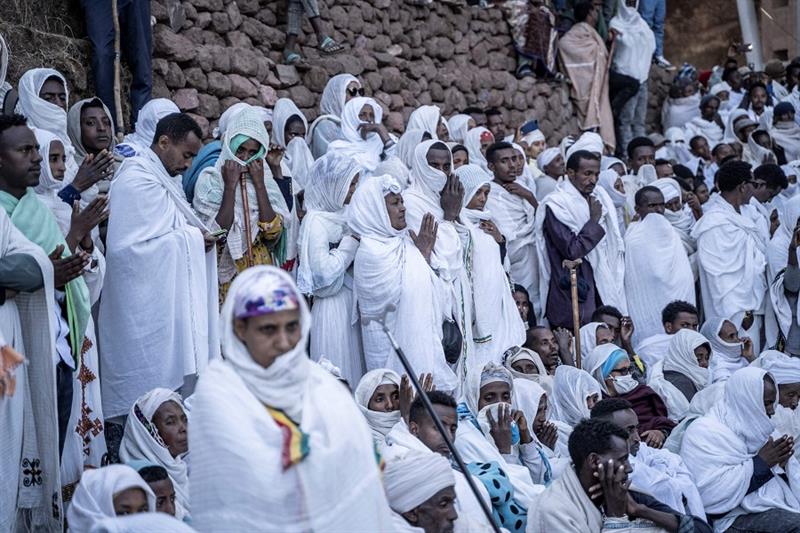
Two months after a ceasefire deal between the Ethiopian government and Tigray rebels to end two years of a devastating war, Africa’s largest Christian site is alive with excitement and religious fervour as the faithful flock to Lalibela for the festivities.
A white tide of tens of thousands of worshippers of all ages, draped in their immaculate “netela” (a shawl covering the head and shoulders), thronged the UNESCO World Heritage Site and its magnificent rock-hewn 12th and 13th-century churches.
In recent years, the crowds were much sparser in Amhara town, one of Ethiopia’s holiest and most storied places.
Lalibela lies only 40 kilometres (25 miles) as the crow flies from Tigray, where the conflict erupted between government forces and the Tigray People’s Liberation Front (TPLF) in November 2020, spilling over periodically into neighbouring regions.
The town itself was at the centre of a fierce struggle between the warring sides, changing hands four times during the fighting, although the ancient churches appear to have been spared the scars of war.
Seized by Tigray rebels in an offensive in mid-2021, it was recaptured by pro-government forces on December 1, 2021, before falling back into the hands of TPLF fighters 10 days later. The rebels finally left Lalibela at the end of December of that year after they announced a withdrawal to their Tigray stronghold.
A surprise peace deal was signed last November 2 in the South African capital Pretoria to silence the guns in northern Ethiopia and allow the gradual resumption of humanitarian aid and the restoration of basic services — communications, electricity, banking, transport — in Tigray, long cut off from the outside world.
‘So many people’
“I wanted to come last year but I couldn’t because of the war,” says Asme, who travelled from Wolkait in western Tigray, a disputed area claimed by both the Amhara and Tigrayan ethnic groups.
“I didn’t expect so many people to be here,” says the 30-year-old science teacher of Amhara origin.
The Pretoria agreement has allowed traffic to resume in northern Ethiopia, so Asme came to Lalibela by bus with fellow pilgrims from his home village.
Others arrived on foot from surrounding villages, by car, or by plane from the capital Addis Ababa and abroad from countries such as Britain, German and the United States.
Asme described the atmosphere of the festival as “special”.
“Even the greetings among each other are unique because people have missed each other. Everybody is excited about peace.”
Lalibela’s high priest Kengeta Belay said he was “overwhelmed” by the numbers joining the celebrations.
“This is the benefit of peace. People are coming from all four directions to worship freely without fear of anything… My joy is boundless.”
“I have been attending the festivities for over 40 years. I was born and raised here and became a priest. This year’s celebration is the biggest crowd of pilgrims I’ve ever seen,” smiled the 55-year-old clergyman, just minutes before the start of a night of candlelit ceremonies.
‘Prayers for freedom’
Massed in and around Lalibela’s unique complex of churches — but also on surrounding hills and even in trees, the faithful sang, prayed, ate, slept or enjoyed long discussions with their fellow pilgrims.
Songs, psalms and ululations rang out from Saint Mary’s church, the oldest of the 11 stone houses of worship and the heart of celebrations for Genna (Christmas in Amharic).
With her eyes closed and her head bent over a prayer stick, Bethlehem said she was savouring the “peaceful and joyful atmosphere” of the festivities.
“Our country was unstable in the past few years, there was war. Thanks to God, all that has passed,” said the young banker from Addis Ababa, who did not want to give her family name or age.
“Today, I witnessed that peace is worth more than anything. My prayer and my wish is that God grants freedom for my country, for myself, and for all of us.”
Akogo: making the thumb piano to keep Teso culture alive
By Rédaction Africanews and Raziah Athman
The akogo, one of the most popular musical instruments in Uganda. It belongs to the Iteso, who designed it centuries ago.
The thumb piano is traditionally played at sacred ceremonies like the birth of twins, marriage or a funeral.
Okopa Kokas has been making akogo since he was 15.
The 77-year-old subsistence farmer made extra money with orders for bands but today the fading of a unique sound wakes in him the urge to save what embodies the Teso culture.
“I want to teach the children of the children of this generation, so that when they grow up they can find the akogo and know that it is the culture we grew up with. And they can also ask about the different parts of the instrument”.
Except for mega traditional events, the mighty akogo mostly lies in caskets at museums.
“We have the Teso children in town who don’t even know akogo. So, when they visit the Soroti Museum, they will find them here preserved and they can see”, Peter Natsami, a guide at the Soroti Museum says.
With the advent of computerized music production, the akogo melodies can be sequenced.
And, in the mix of wild genres, it is difficult to interest this generation in akogo sounds.
“There will come a time when God will take me away only to find that no one knows about our culture and it is dead. That is why I am encouraging the children who are interested to come and learn”.
Making the akogo was tedious back then when it needed to be curved out of a trunk.
Now with the availability of materials, it takes just a few hours to get one ready.
Kokas is selling what he has made at $5, however, it is not about money for him. It is a quest to keep the Teso culture alive while saving a sound that is slowly disappearing.
Raziah Athman, reporting for Africanews, in Soroti, Uganda.
Congo-Brazzaville: Passy Mermans of the Bantous de la Capitale dies
cleared
By Rédaction Africanews and Cédric Lyonnel Sehossolo
The Bantous de la Capitale, the first Congolese orchestra created in 1959, has lost its last founding father. The guitarist Passy Mermans, alias “Mermans the first”, died last Wednesday in Brazzaville at the age of 80.
The death of Mermans, who played guitar for one of the oldest orchestras in Africa, comes after those of his colleagues Henri Gilbert Adampot, and Ricky Simeon Malonga – a hard blow for the rest of the members of the group.
“It’s difficult, you lose at the same time, first Richy followed by the death of Adampot, and a few days later the old Mermans.”
“Mermans was a good guy, a sound artist and in life, he was a man who dealt with everyone, and he loved his job, ” a member of Bantous de la Capitale, Kosmos Moutouari, said.
The demise of the fathers of Congolese rumba reopens the debate on the preservation of the musical heritage of the orchestra and the redistribution of their copyright.
“These founding fathers did not have the time to solve the problem of the earnings of their music generated by international distribution platforms, whereas today we have local platforms that secure the sale of these songs,” the director of Wilkai Music told Africanews.
According to Africanews Journalist Cédric Lyonnel Sehossolo, the orchestra has been preparing for who will succeed them for several years.
But the elders had impressed on the younger members of the band that they must preserve Congolese rumba.
Gaza authorities discover over 60 Roman era graves
AP , Sunday 11 Dec 2022
Hamas authorities in Gaza on Sunday announced the discovery of over 60 tombs in an ancient burial site dating back to the Roman era.
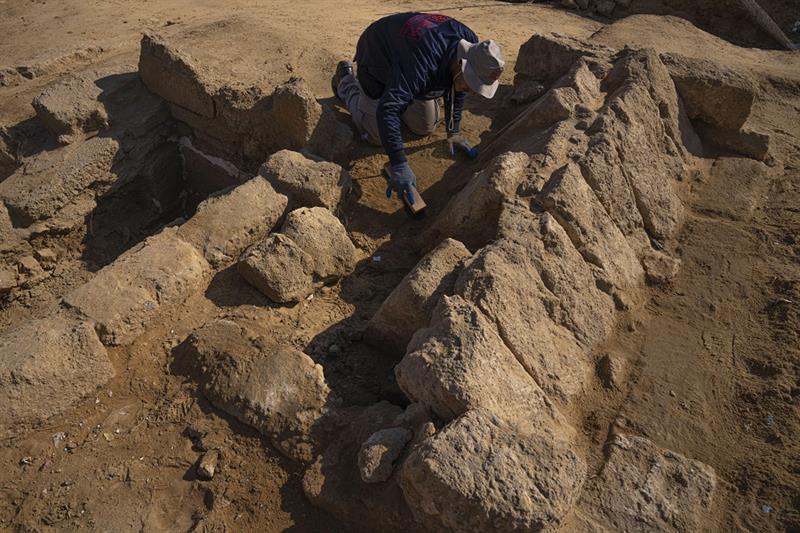
Work crews have been excavating the site since it was discovered last January during preparations for an Egyptian-funded housing project.
Hiyam al-Bitar, a researcher from the Hamas-run Ministry of Antiquities and Tourism, said a total of 63 graves have been identified and that a set of bones and artifacts from one tomb was dated back to the second century.
She said the ministry is working with a team of French experts to learn more about the site. On Sunday, workers sifted through the soil and removed piles of dirt in wheelbarrows.
Although the ancient cemetery is now blocked off from the public, construction on the housing project has continued and the site is surrounded by apartment buildings.
Local media reported looting when the site was first discovered, with people using donkey-drawn carts to haul away items like a covered casket and inscribed bricks.
Gaza, a coastal enclave home to more than 2 million people, is known for its rich history stemming from its location on ancient trade routes between Egypt and the Levant.
But Israeli occupation, a blockade, conflicts, and rapid urban growth in the crowded, narrow territory are among the reasons most of Gaza’s archeological treasures have not been protected.
“Wakanda” goes on to lead the North American box office for a 4th week
PIUS UTOMI EKPEI/AFP or licensors
nterest in “Black Panther: Wakanda Forever” has waned slightly, but the Marvel film still sold $17.6 million worth of tickets in the United States and Canada, topping the North American box office for a fourth straight weekend, according to figures from trade firm Exhibitor Relations on Sunday.
The sequel to the 2018 blockbuster Afro-futuristic film, which pays a heartfelt tribute to Chadwick Boseman, the star of the original “Black Panther,” has now amassed $393.7 million in North America alone, in addition to $339 million internationally.
In second place was “Violent Night”, in which “Stranger Things” star David Harbour plays a grumpy, sledgehammer-wielding Father Christmas when evil people break into a wealthy family’s home.
The Christmas film totalled 13.3 million, “a solid outing for an action comedy”, according to expert David Gross.
In third place, Disney’s animated film “Avalonia, The Strange Journey”, took in only 4.9 million after an already disappointing first weekend. Given its $180 million budget, the film could lose over $100 million, according to the Hollywood Reporter.
“The Menu, a film that borrows from horror, film noir and gritty comedy, came in fourth with $3.6 million.
In fifth place, “Devotion”, the story of two U.S. Navy fighter pilots, earned 2.8 million.
Dior showcases fashion in shadow of Egypt’s pyramids
AFP , Saturday 3 Dec 2022
French fashion house Dior on Saturday held its first show at Egypt’s ancient Giza pyramids, presenting its 2023 fall men’s collection in the shadow of the millennia-old tombs.
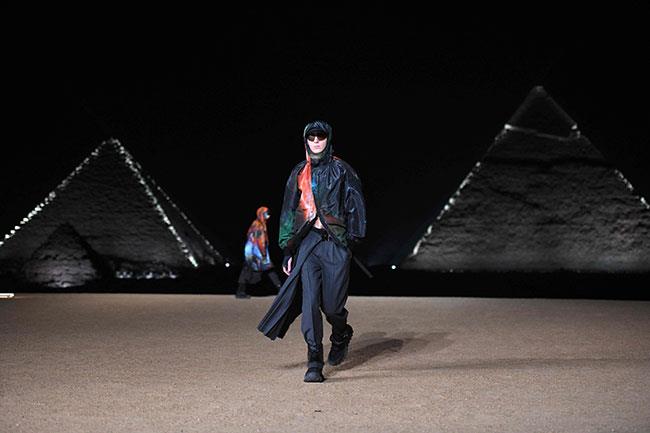
Dwarfed by the vast Giza necropolis — their imposing ridges illuminated by white light for the show — models showcased the collection titled “Celestial”.
Saturday’s show was the second by a European fashion house to use Ancient Egyptian heritage sites as a backdrop this year.
In October, Italian designer Stefano Ricci showcased his most recent collection at the Temple of Hatshepsut in Luxor.
Egypt’s Giza necropolis, just west of the capital Cairo, has in recent years played host to ever-grander events, including pop concerts and contemporary art exhibitions, as the North African country seeks to project a revitalised image to draw in new tourism and business.
Media entrepreneur Amy Mowafi said events like Dior’s “put Egypt on the map as a new hub for creativity and design” where creators can draw on “seven thousand years of inspiration.”






